Healthcare: The Role of Information Systems in Pharmacy Report
VerifiedAdded on 2019/10/09
|9
|2258
|146
Report
AI Summary
This report analyzes the role of information systems in pharmacy, beginning with an introduction to Al Manara group's adoption of IT. It details the system architecture, focusing on the Pharmacy Plus system and the HL7 interface, and discusses the history of information technology in healthcare, including the evolution of systems from administrative tasks to patient-centric solutions. The report emphasizes the importance of IT in healthcare, highlighting benefits such as improved patient care and reduced costs, while also acknowledging limitations like medical errors. It concludes with a look at the future of IT in healthcare, including telemedicine and the integration of various technologies. The report references various sources to support its findings and provides a comprehensive overview of IT's impact on the pharmaceutical industry.
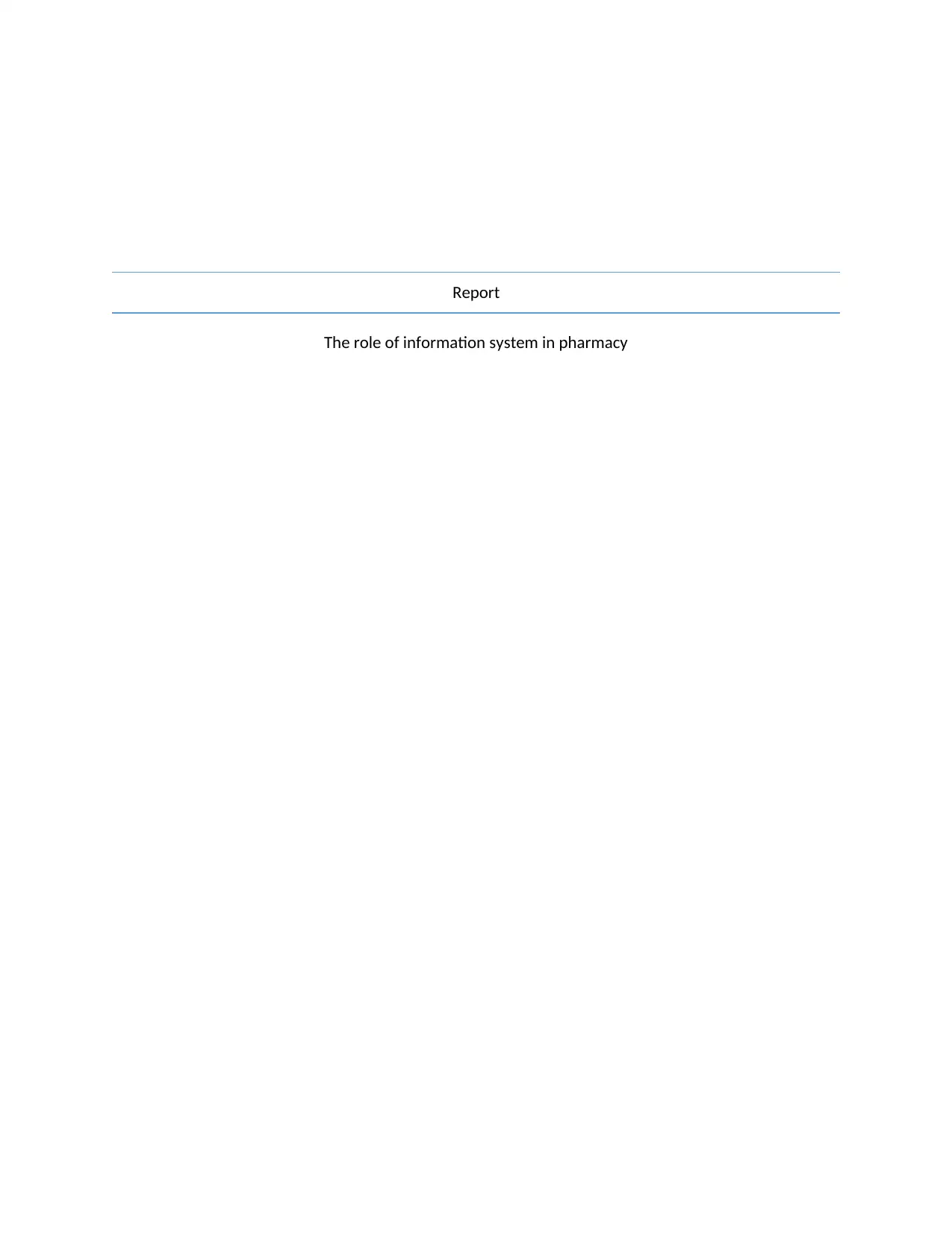
Report
The role of information system in pharmacy
The role of information system in pharmacy
Paraphrase This Document
Need a fresh take? Get an instant paraphrase of this document with our AI Paraphraser
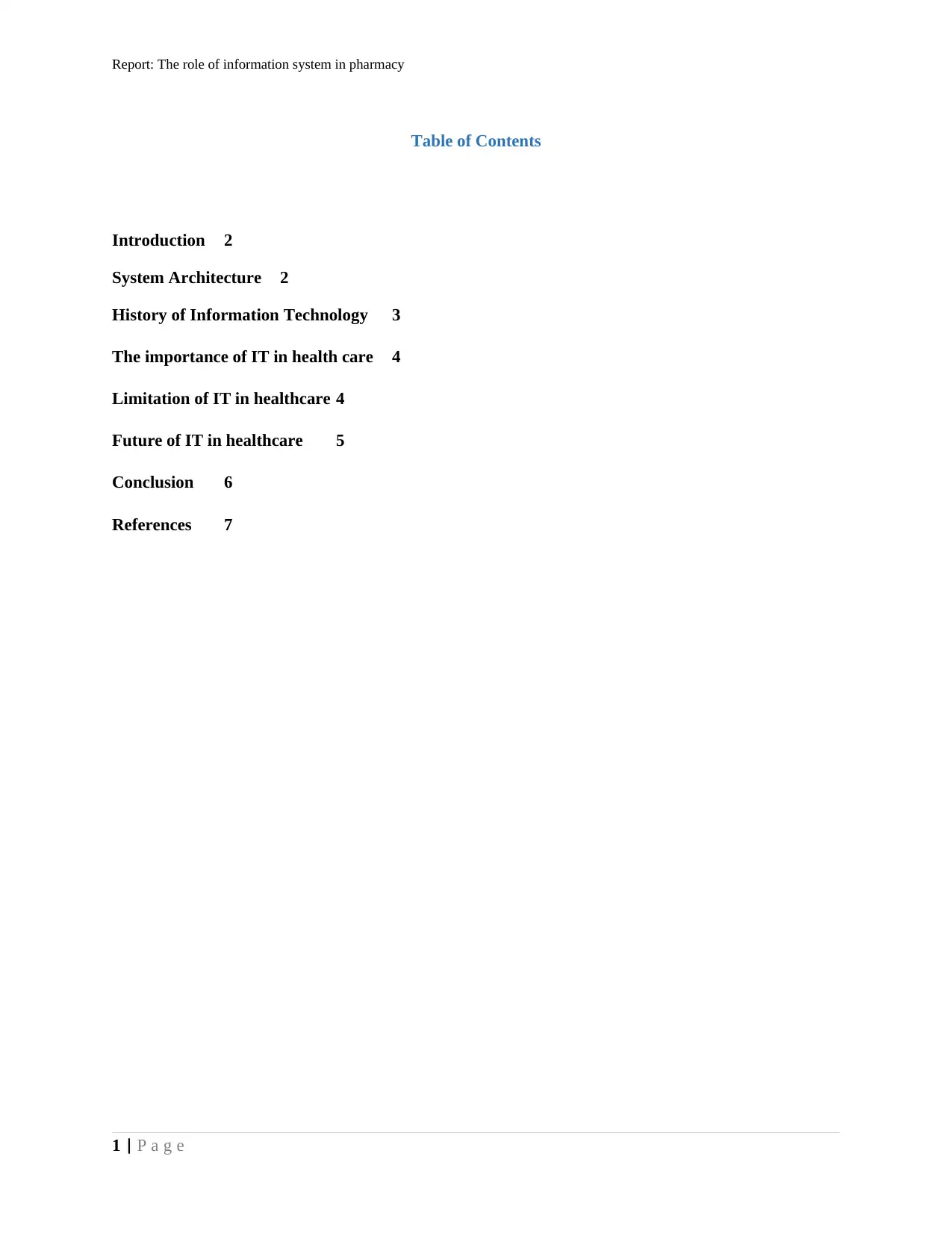
Report: The role of information system in pharmacy
Table of Contents
Introduction 2
System Architecture 2
History of Information Technology 3
The importance of IT in health care 4
Limitation of IT in healthcare 4
Future of IT in healthcare 5
Conclusion 6
References 7
1 | P a g e
Table of Contents
Introduction 2
System Architecture 2
History of Information Technology 3
The importance of IT in health care 4
Limitation of IT in healthcare 4
Future of IT in healthcare 5
Conclusion 6
References 7
1 | P a g e
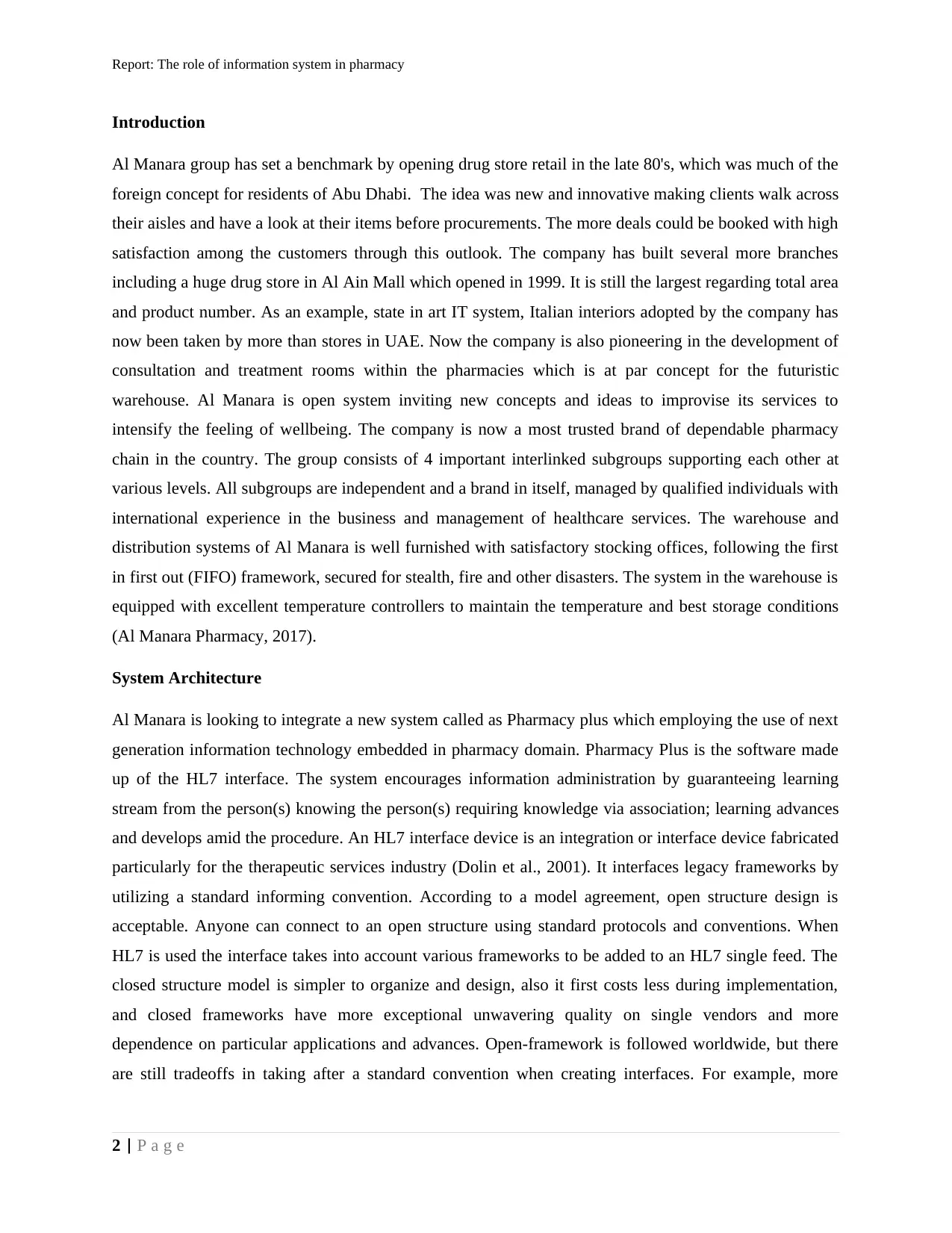
Report: The role of information system in pharmacy
Introduction
Al Manara group has set a benchmark by opening drug store retail in the late 80's, which was much of the
foreign concept for residents of Abu Dhabi. The idea was new and innovative making clients walk across
their aisles and have a look at their items before procurements. The more deals could be booked with high
satisfaction among the customers through this outlook. The company has built several more branches
including a huge drug store in Al Ain Mall which opened in 1999. It is still the largest regarding total area
and product number. As an example, state in art IT system, Italian interiors adopted by the company has
now been taken by more than stores in UAE. Now the company is also pioneering in the development of
consultation and treatment rooms within the pharmacies which is at par concept for the futuristic
warehouse. Al Manara is open system inviting new concepts and ideas to improvise its services to
intensify the feeling of wellbeing. The company is now a most trusted brand of dependable pharmacy
chain in the country. The group consists of 4 important interlinked subgroups supporting each other at
various levels. All subgroups are independent and a brand in itself, managed by qualified individuals with
international experience in the business and management of healthcare services. The warehouse and
distribution systems of Al Manara is well furnished with satisfactory stocking offices, following the first
in first out (FIFO) framework, secured for stealth, fire and other disasters. The system in the warehouse is
equipped with excellent temperature controllers to maintain the temperature and best storage conditions
(Al Manara Pharmacy, 2017).
System Architecture
Al Manara is looking to integrate a new system called as Pharmacy plus which employing the use of next
generation information technology embedded in pharmacy domain. Pharmacy Plus is the software made
up of the HL7 interface. The system encourages information administration by guaranteeing learning
stream from the person(s) knowing the person(s) requiring knowledge via association; learning advances
and develops amid the procedure. An HL7 interface device is an integration or interface device fabricated
particularly for the therapeutic services industry (Dolin et al., 2001). It interfaces legacy frameworks by
utilizing a standard informing convention. According to a model agreement, open structure design is
acceptable. Anyone can connect to an open structure using standard protocols and conventions. When
HL7 is used the interface takes into account various frameworks to be added to an HL7 single feed. The
closed structure model is simpler to organize and design, also it first costs less during implementation,
and closed frameworks have more exceptional unwavering quality on single vendors and more
dependence on particular applications and advances. Open-framework is followed worldwide, but there
are still tradeoffs in taking after a standard convention when creating interfaces. For example, more
2 | P a g e
Introduction
Al Manara group has set a benchmark by opening drug store retail in the late 80's, which was much of the
foreign concept for residents of Abu Dhabi. The idea was new and innovative making clients walk across
their aisles and have a look at their items before procurements. The more deals could be booked with high
satisfaction among the customers through this outlook. The company has built several more branches
including a huge drug store in Al Ain Mall which opened in 1999. It is still the largest regarding total area
and product number. As an example, state in art IT system, Italian interiors adopted by the company has
now been taken by more than stores in UAE. Now the company is also pioneering in the development of
consultation and treatment rooms within the pharmacies which is at par concept for the futuristic
warehouse. Al Manara is open system inviting new concepts and ideas to improvise its services to
intensify the feeling of wellbeing. The company is now a most trusted brand of dependable pharmacy
chain in the country. The group consists of 4 important interlinked subgroups supporting each other at
various levels. All subgroups are independent and a brand in itself, managed by qualified individuals with
international experience in the business and management of healthcare services. The warehouse and
distribution systems of Al Manara is well furnished with satisfactory stocking offices, following the first
in first out (FIFO) framework, secured for stealth, fire and other disasters. The system in the warehouse is
equipped with excellent temperature controllers to maintain the temperature and best storage conditions
(Al Manara Pharmacy, 2017).
System Architecture
Al Manara is looking to integrate a new system called as Pharmacy plus which employing the use of next
generation information technology embedded in pharmacy domain. Pharmacy Plus is the software made
up of the HL7 interface. The system encourages information administration by guaranteeing learning
stream from the person(s) knowing the person(s) requiring knowledge via association; learning advances
and develops amid the procedure. An HL7 interface device is an integration or interface device fabricated
particularly for the therapeutic services industry (Dolin et al., 2001). It interfaces legacy frameworks by
utilizing a standard informing convention. According to a model agreement, open structure design is
acceptable. Anyone can connect to an open structure using standard protocols and conventions. When
HL7 is used the interface takes into account various frameworks to be added to an HL7 single feed. The
closed structure model is simpler to organize and design, also it first costs less during implementation,
and closed frameworks have more exceptional unwavering quality on single vendors and more
dependence on particular applications and advances. Open-framework is followed worldwide, but there
are still tradeoffs in taking after a standard convention when creating interfaces. For example, more
2 | P a g e
⊘ This is a preview!⊘
Do you want full access?
Subscribe today to unlock all pages.

Trusted by 1+ million students worldwide
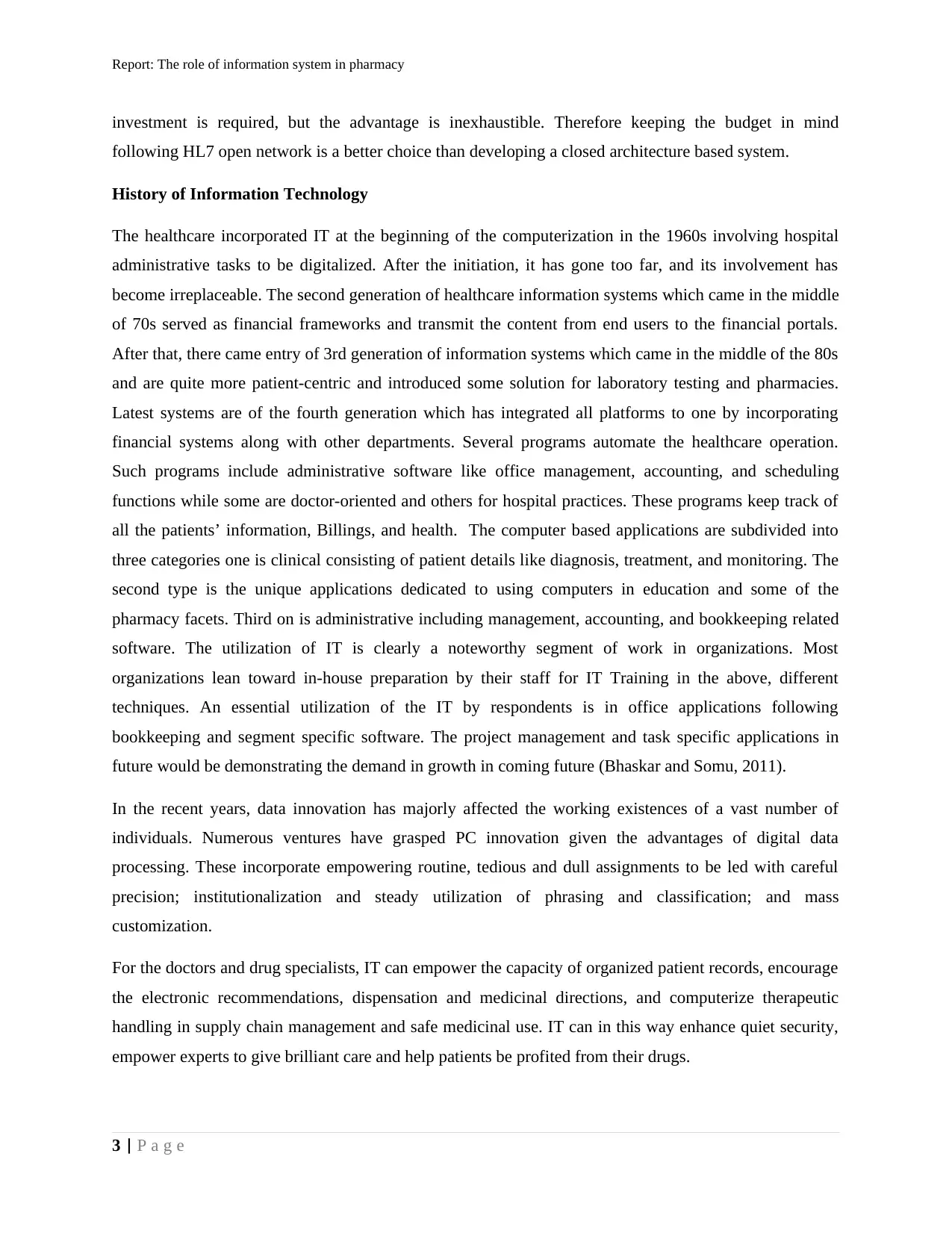
Report: The role of information system in pharmacy
investment is required, but the advantage is inexhaustible. Therefore keeping the budget in mind
following HL7 open network is a better choice than developing a closed architecture based system.
History of Information Technology
The healthcare incorporated IT at the beginning of the computerization in the 1960s involving hospital
administrative tasks to be digitalized. After the initiation, it has gone too far, and its involvement has
become irreplaceable. The second generation of healthcare information systems which came in the middle
of 70s served as financial frameworks and transmit the content from end users to the financial portals.
After that, there came entry of 3rd generation of information systems which came in the middle of the 80s
and are quite more patient-centric and introduced some solution for laboratory testing and pharmacies.
Latest systems are of the fourth generation which has integrated all platforms to one by incorporating
financial systems along with other departments. Several programs automate the healthcare operation.
Such programs include administrative software like office management, accounting, and scheduling
functions while some are doctor-oriented and others for hospital practices. These programs keep track of
all the patients’ information, Billings, and health. The computer based applications are subdivided into
three categories one is clinical consisting of patient details like diagnosis, treatment, and monitoring. The
second type is the unique applications dedicated to using computers in education and some of the
pharmacy facets. Third on is administrative including management, accounting, and bookkeeping related
software. The utilization of IT is clearly a noteworthy segment of work in organizations. Most
organizations lean toward in-house preparation by their staff for IT Training in the above, different
techniques. An essential utilization of the IT by respondents is in office applications following
bookkeeping and segment specific software. The project management and task specific applications in
future would be demonstrating the demand in growth in coming future (Bhaskar and Somu, 2011).
In the recent years, data innovation has majorly affected the working existences of a vast number of
individuals. Numerous ventures have grasped PC innovation given the advantages of digital data
processing. These incorporate empowering routine, tedious and dull assignments to be led with careful
precision; institutionalization and steady utilization of phrasing and classification; and mass
customization.
For the doctors and drug specialists, IT can empower the capacity of organized patient records, encourage
the electronic recommendations, dispensation and medicinal directions, and computerize therapeutic
handling in supply chain management and safe medicinal use. IT can in this way enhance quiet security,
empower experts to give brilliant care and help patients be profited from their drugs.
3 | P a g e
investment is required, but the advantage is inexhaustible. Therefore keeping the budget in mind
following HL7 open network is a better choice than developing a closed architecture based system.
History of Information Technology
The healthcare incorporated IT at the beginning of the computerization in the 1960s involving hospital
administrative tasks to be digitalized. After the initiation, it has gone too far, and its involvement has
become irreplaceable. The second generation of healthcare information systems which came in the middle
of 70s served as financial frameworks and transmit the content from end users to the financial portals.
After that, there came entry of 3rd generation of information systems which came in the middle of the 80s
and are quite more patient-centric and introduced some solution for laboratory testing and pharmacies.
Latest systems are of the fourth generation which has integrated all platforms to one by incorporating
financial systems along with other departments. Several programs automate the healthcare operation.
Such programs include administrative software like office management, accounting, and scheduling
functions while some are doctor-oriented and others for hospital practices. These programs keep track of
all the patients’ information, Billings, and health. The computer based applications are subdivided into
three categories one is clinical consisting of patient details like diagnosis, treatment, and monitoring. The
second type is the unique applications dedicated to using computers in education and some of the
pharmacy facets. Third on is administrative including management, accounting, and bookkeeping related
software. The utilization of IT is clearly a noteworthy segment of work in organizations. Most
organizations lean toward in-house preparation by their staff for IT Training in the above, different
techniques. An essential utilization of the IT by respondents is in office applications following
bookkeeping and segment specific software. The project management and task specific applications in
future would be demonstrating the demand in growth in coming future (Bhaskar and Somu, 2011).
In the recent years, data innovation has majorly affected the working existences of a vast number of
individuals. Numerous ventures have grasped PC innovation given the advantages of digital data
processing. These incorporate empowering routine, tedious and dull assignments to be led with careful
precision; institutionalization and steady utilization of phrasing and classification; and mass
customization.
For the doctors and drug specialists, IT can empower the capacity of organized patient records, encourage
the electronic recommendations, dispensation and medicinal directions, and computerize therapeutic
handling in supply chain management and safe medicinal use. IT can in this way enhance quiet security,
empower experts to give brilliant care and help patients be profited from their drugs.
3 | P a g e
Paraphrase This Document
Need a fresh take? Get an instant paraphrase of this document with our AI Paraphraser
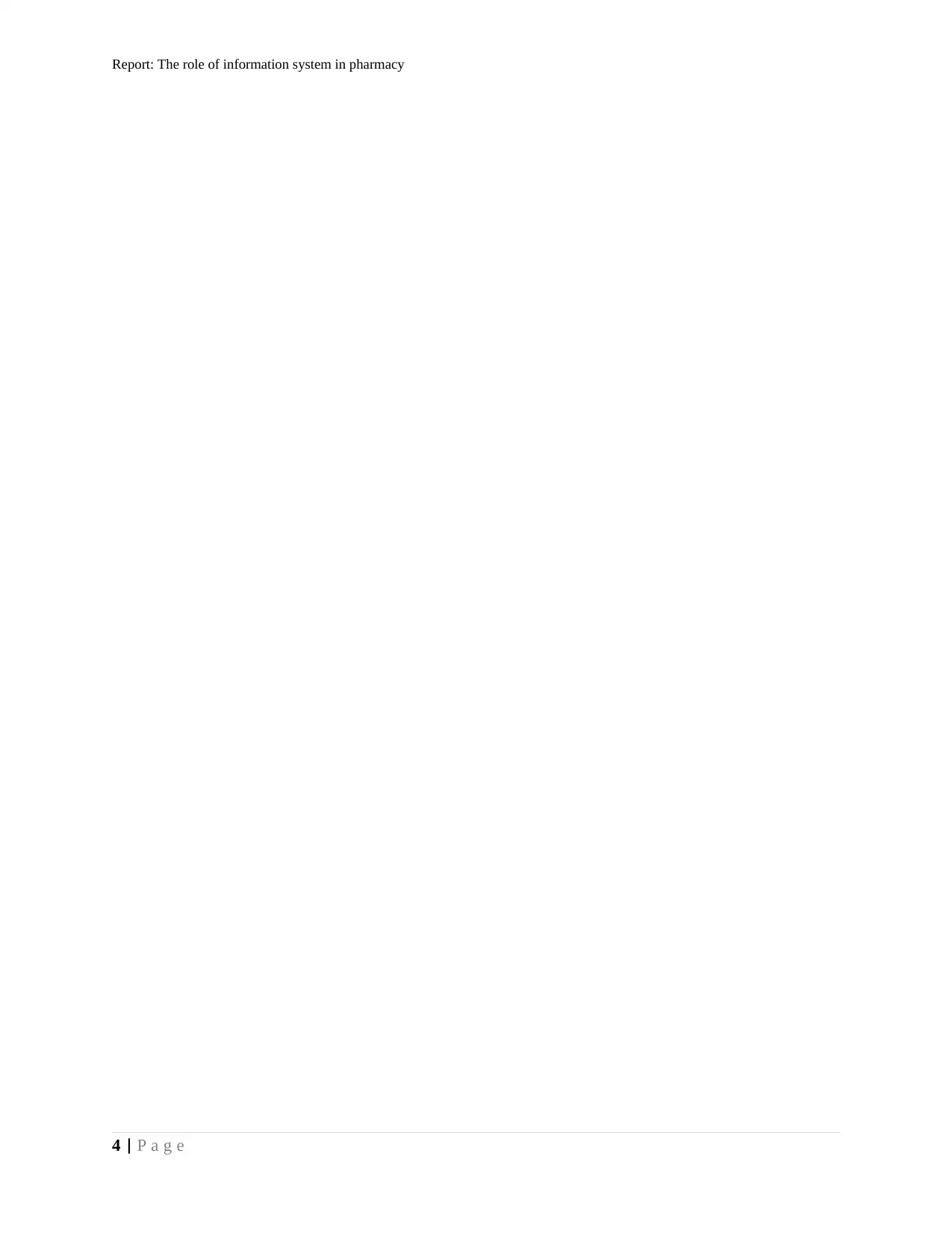
Report: The role of information system in pharmacy
4 | P a g e
4 | P a g e

Report: The role of information system in pharmacy
The importance of IT in health care
Information technology has great use in the healthcare industry as an example by innovating the drug
store is of great significance for the pharmaceutical professionals, as it develops the client base.
Computational inputs assist in better bookkeeping of patient’s records, medications, management of
resources, patient counseling and medication plan. It reduces the expenses, time and efforts required for
any work. The use of healthcare is not only for the professionals but also for the benefits of patients and
medicinal service providers as it brings down the cost enhances the efficiency and profitability. The better
communication and healthcare delivery along with reimbursement procedures. The healthcare benefits
could postulate in following points (Soffar, 2016):
• Improved nature of healthcare
• Prevention of medical blunders
• Health care cost reduction
• Regulatory processes become efficient
• Amount of paperwork decreases
• More affordability in healthcare
• Early detection of contagious diseases
• Improved disease management in case of severe disease outbreak
Limitation of IT in healthcare
Druggists need to expand their insight and encounters with hospital information technology (HIT) to
confront the cluster of chances and difficulties displayed by electronic health care. Since they are at the
focal point of the healing process, drug specialists will soon be confronted with taking care of the
multidirectional stream of all wellbeing care–related information and different automatic dispensers along
with billing process. Drug stores from electronic prescribing (e-prescribing) to point-of-sale (POS)
innovation will soon be electronically associated with various suppliers and patients previously pro-
industrialist, but now it is government run. Like it or not, drug specialists are on a roller coaster when
they adopt prepare to electronically coordinated drug store practices, and making such move requires
flexibility and collaboration from rest of healthcare community.
Although, doctors have been ease back to execute new advancements, there has been a public risk
associated with its implementation and use of modern technology. Reports say that due to the use of HIT
5 | P a g e
The importance of IT in health care
Information technology has great use in the healthcare industry as an example by innovating the drug
store is of great significance for the pharmaceutical professionals, as it develops the client base.
Computational inputs assist in better bookkeeping of patient’s records, medications, management of
resources, patient counseling and medication plan. It reduces the expenses, time and efforts required for
any work. The use of healthcare is not only for the professionals but also for the benefits of patients and
medicinal service providers as it brings down the cost enhances the efficiency and profitability. The better
communication and healthcare delivery along with reimbursement procedures. The healthcare benefits
could postulate in following points (Soffar, 2016):
• Improved nature of healthcare
• Prevention of medical blunders
• Health care cost reduction
• Regulatory processes become efficient
• Amount of paperwork decreases
• More affordability in healthcare
• Early detection of contagious diseases
• Improved disease management in case of severe disease outbreak
Limitation of IT in healthcare
Druggists need to expand their insight and encounters with hospital information technology (HIT) to
confront the cluster of chances and difficulties displayed by electronic health care. Since they are at the
focal point of the healing process, drug specialists will soon be confronted with taking care of the
multidirectional stream of all wellbeing care–related information and different automatic dispensers along
with billing process. Drug stores from electronic prescribing (e-prescribing) to point-of-sale (POS)
innovation will soon be electronically associated with various suppliers and patients previously pro-
industrialist, but now it is government run. Like it or not, drug specialists are on a roller coaster when
they adopt prepare to electronically coordinated drug store practices, and making such move requires
flexibility and collaboration from rest of healthcare community.
Although, doctors have been ease back to execute new advancements, there has been a public risk
associated with its implementation and use of modern technology. Reports say that due to the use of HIT
5 | P a g e
⊘ This is a preview!⊘
Do you want full access?
Subscribe today to unlock all pages.

Trusted by 1+ million students worldwide
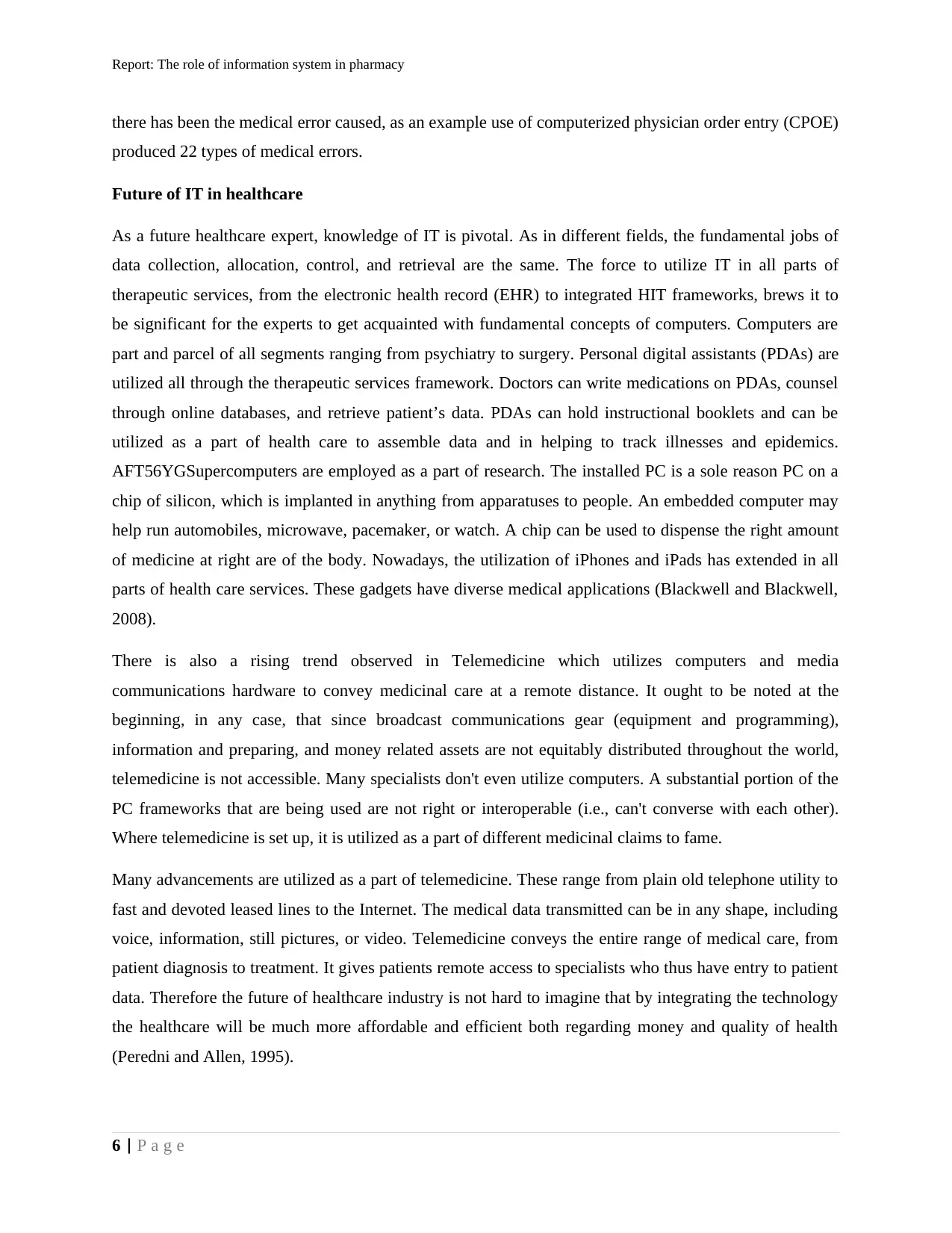
Report: The role of information system in pharmacy
there has been the medical error caused, as an example use of computerized physician order entry (CPOE)
produced 22 types of medical errors.
Future of IT in healthcare
As a future healthcare expert, knowledge of IT is pivotal. As in different fields, the fundamental jobs of
data collection, allocation, control, and retrieval are the same. The force to utilize IT in all parts of
therapeutic services, from the electronic health record (EHR) to integrated HIT frameworks, brews it to
be significant for the experts to get acquainted with fundamental concepts of computers. Computers are
part and parcel of all segments ranging from psychiatry to surgery. Personal digital assistants (PDAs) are
utilized all through the therapeutic services framework. Doctors can write medications on PDAs, counsel
through online databases, and retrieve patient’s data. PDAs can hold instructional booklets and can be
utilized as a part of health care to assemble data and in helping to track illnesses and epidemics.
AFT56YGSupercomputers are employed as a part of research. The installed PC is a sole reason PC on a
chip of silicon, which is implanted in anything from apparatuses to people. An embedded computer may
help run automobiles, microwave, pacemaker, or watch. A chip can be used to dispense the right amount
of medicine at right are of the body. Nowadays, the utilization of iPhones and iPads has extended in all
parts of health care services. These gadgets have diverse medical applications (Blackwell and Blackwell,
2008).
There is also a rising trend observed in Telemedicine which utilizes computers and media
communications hardware to convey medicinal care at a remote distance. It ought to be noted at the
beginning, in any case, that since broadcast communications gear (equipment and programming),
information and preparing, and money related assets are not equitably distributed throughout the world,
telemedicine is not accessible. Many specialists don't even utilize computers. A substantial portion of the
PC frameworks that are being used are not right or interoperable (i.e., can't converse with each other).
Where telemedicine is set up, it is utilized as a part of different medicinal claims to fame.
Many advancements are utilized as a part of telemedicine. These range from plain old telephone utility to
fast and devoted leased lines to the Internet. The medical data transmitted can be in any shape, including
voice, information, still pictures, or video. Telemedicine conveys the entire range of medical care, from
patient diagnosis to treatment. It gives patients remote access to specialists who thus have entry to patient
data. Therefore the future of healthcare industry is not hard to imagine that by integrating the technology
the healthcare will be much more affordable and efficient both regarding money and quality of health
(Peredni and Allen, 1995).
6 | P a g e
there has been the medical error caused, as an example use of computerized physician order entry (CPOE)
produced 22 types of medical errors.
Future of IT in healthcare
As a future healthcare expert, knowledge of IT is pivotal. As in different fields, the fundamental jobs of
data collection, allocation, control, and retrieval are the same. The force to utilize IT in all parts of
therapeutic services, from the electronic health record (EHR) to integrated HIT frameworks, brews it to
be significant for the experts to get acquainted with fundamental concepts of computers. Computers are
part and parcel of all segments ranging from psychiatry to surgery. Personal digital assistants (PDAs) are
utilized all through the therapeutic services framework. Doctors can write medications on PDAs, counsel
through online databases, and retrieve patient’s data. PDAs can hold instructional booklets and can be
utilized as a part of health care to assemble data and in helping to track illnesses and epidemics.
AFT56YGSupercomputers are employed as a part of research. The installed PC is a sole reason PC on a
chip of silicon, which is implanted in anything from apparatuses to people. An embedded computer may
help run automobiles, microwave, pacemaker, or watch. A chip can be used to dispense the right amount
of medicine at right are of the body. Nowadays, the utilization of iPhones and iPads has extended in all
parts of health care services. These gadgets have diverse medical applications (Blackwell and Blackwell,
2008).
There is also a rising trend observed in Telemedicine which utilizes computers and media
communications hardware to convey medicinal care at a remote distance. It ought to be noted at the
beginning, in any case, that since broadcast communications gear (equipment and programming),
information and preparing, and money related assets are not equitably distributed throughout the world,
telemedicine is not accessible. Many specialists don't even utilize computers. A substantial portion of the
PC frameworks that are being used are not right or interoperable (i.e., can't converse with each other).
Where telemedicine is set up, it is utilized as a part of different medicinal claims to fame.
Many advancements are utilized as a part of telemedicine. These range from plain old telephone utility to
fast and devoted leased lines to the Internet. The medical data transmitted can be in any shape, including
voice, information, still pictures, or video. Telemedicine conveys the entire range of medical care, from
patient diagnosis to treatment. It gives patients remote access to specialists who thus have entry to patient
data. Therefore the future of healthcare industry is not hard to imagine that by integrating the technology
the healthcare will be much more affordable and efficient both regarding money and quality of health
(Peredni and Allen, 1995).
6 | P a g e
Paraphrase This Document
Need a fresh take? Get an instant paraphrase of this document with our AI Paraphraser
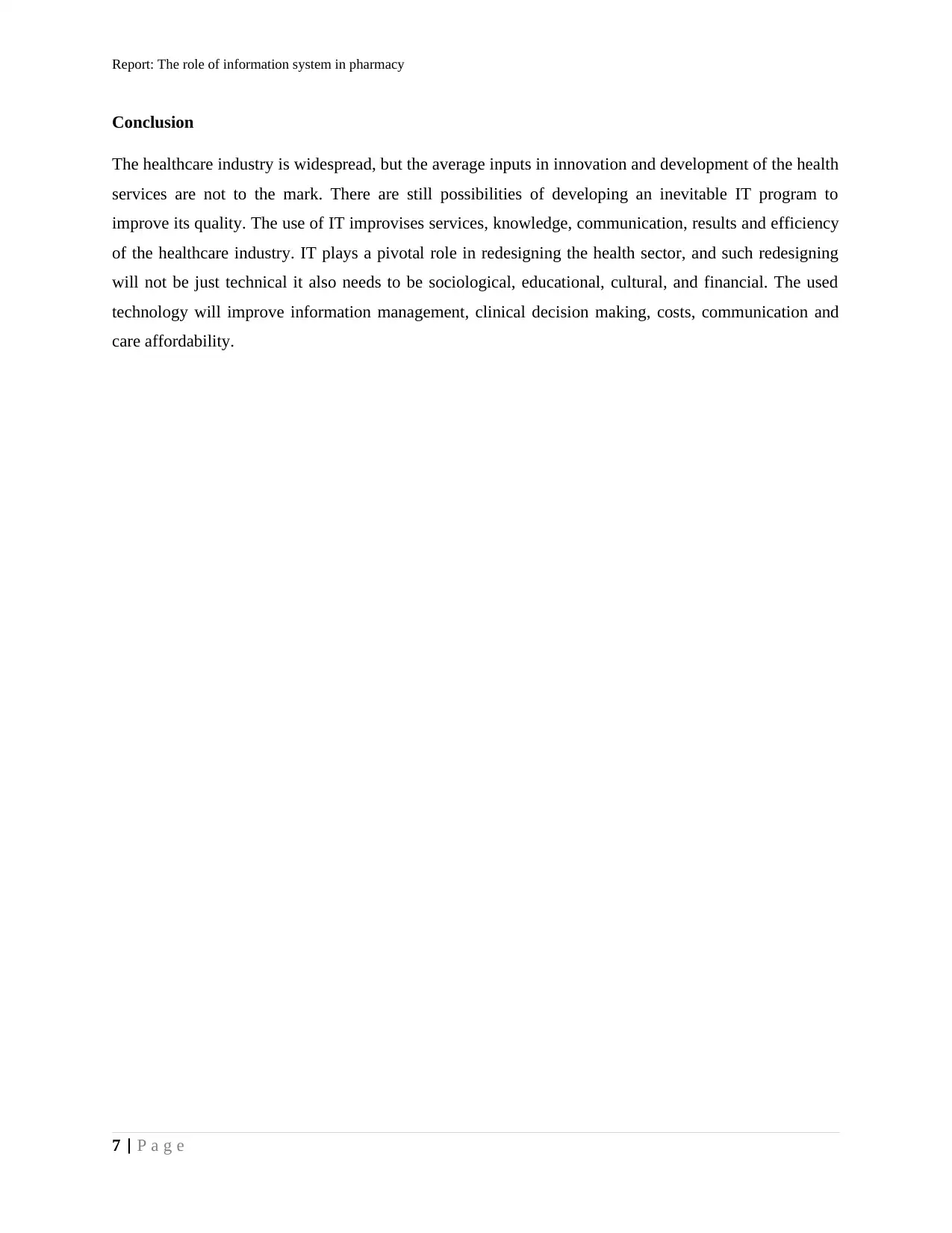
Report: The role of information system in pharmacy
Conclusion
The healthcare industry is widespread, but the average inputs in innovation and development of the health
services are not to the mark. There are still possibilities of developing an inevitable IT program to
improve its quality. The use of IT improvises services, knowledge, communication, results and efficiency
of the healthcare industry. IT plays a pivotal role in redesigning the health sector, and such redesigning
will not be just technical it also needs to be sociological, educational, cultural, and financial. The used
technology will improve information management, clinical decision making, costs, communication and
care affordability.
7 | P a g e
Conclusion
The healthcare industry is widespread, but the average inputs in innovation and development of the health
services are not to the mark. There are still possibilities of developing an inevitable IT program to
improve its quality. The use of IT improvises services, knowledge, communication, results and efficiency
of the healthcare industry. IT plays a pivotal role in redesigning the health sector, and such redesigning
will not be just technical it also needs to be sociological, educational, cultural, and financial. The used
technology will improve information management, clinical decision making, costs, communication and
care affordability.
7 | P a g e
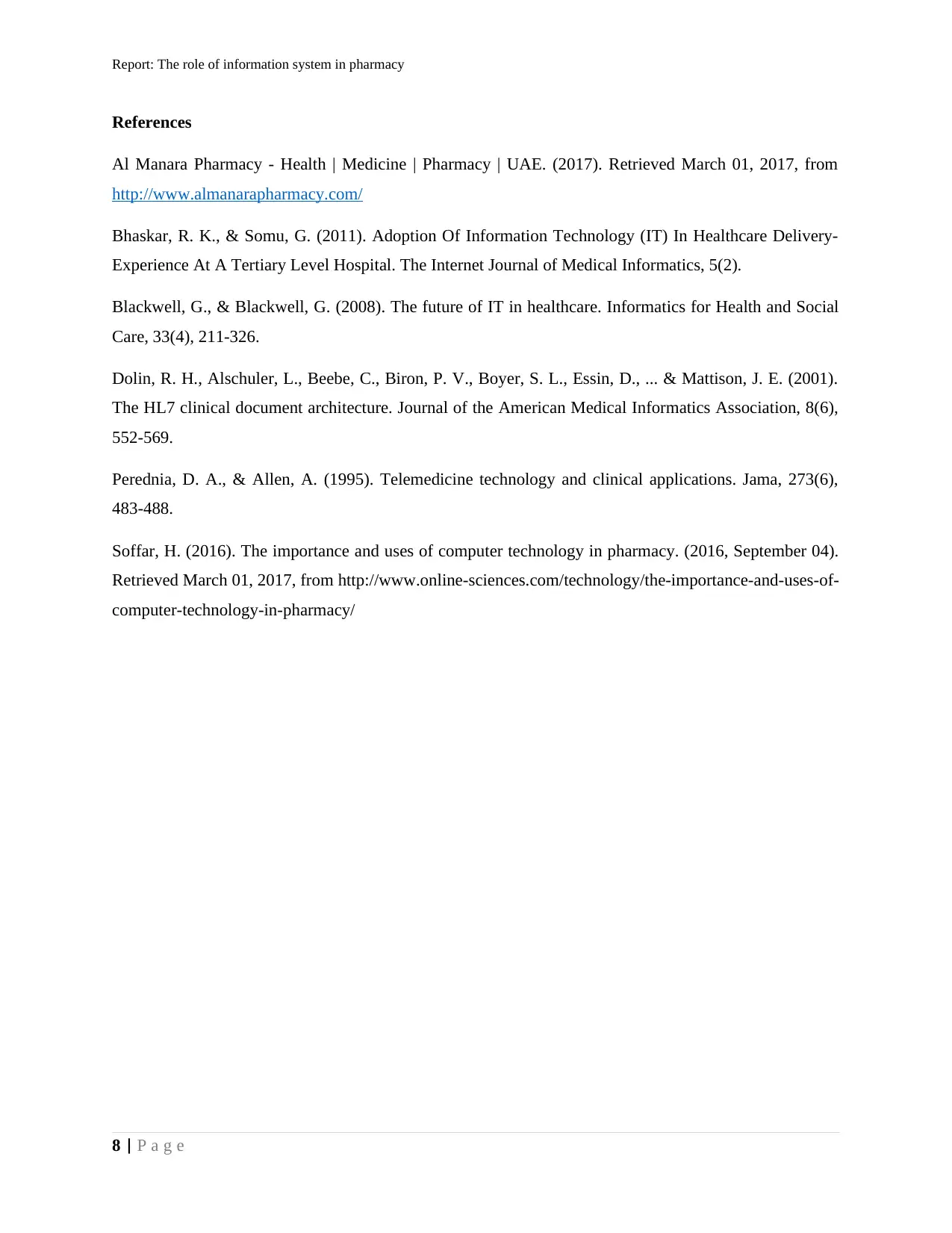
Report: The role of information system in pharmacy
References
Al Manara Pharmacy - Health | Medicine | Pharmacy | UAE. (2017). Retrieved March 01, 2017, from
http://www.almanarapharmacy.com/
Bhaskar, R. K., & Somu, G. (2011). Adoption Of Information Technology (IT) In Healthcare Delivery-
Experience At A Tertiary Level Hospital. The Internet Journal of Medical Informatics, 5(2).
Blackwell, G., & Blackwell, G. (2008). The future of IT in healthcare. Informatics for Health and Social
Care, 33(4), 211-326.
Dolin, R. H., Alschuler, L., Beebe, C., Biron, P. V., Boyer, S. L., Essin, D., ... & Mattison, J. E. (2001).
The HL7 clinical document architecture. Journal of the American Medical Informatics Association, 8(6),
552-569.
Perednia, D. A., & Allen, A. (1995). Telemedicine technology and clinical applications. Jama, 273(6),
483-488.
Soffar, H. (2016). The importance and uses of computer technology in pharmacy. (2016, September 04).
Retrieved March 01, 2017, from http://www.online-sciences.com/technology/the-importance-and-uses-of-
computer-technology-in-pharmacy/
8 | P a g e
References
Al Manara Pharmacy - Health | Medicine | Pharmacy | UAE. (2017). Retrieved March 01, 2017, from
http://www.almanarapharmacy.com/
Bhaskar, R. K., & Somu, G. (2011). Adoption Of Information Technology (IT) In Healthcare Delivery-
Experience At A Tertiary Level Hospital. The Internet Journal of Medical Informatics, 5(2).
Blackwell, G., & Blackwell, G. (2008). The future of IT in healthcare. Informatics for Health and Social
Care, 33(4), 211-326.
Dolin, R. H., Alschuler, L., Beebe, C., Biron, P. V., Boyer, S. L., Essin, D., ... & Mattison, J. E. (2001).
The HL7 clinical document architecture. Journal of the American Medical Informatics Association, 8(6),
552-569.
Perednia, D. A., & Allen, A. (1995). Telemedicine technology and clinical applications. Jama, 273(6),
483-488.
Soffar, H. (2016). The importance and uses of computer technology in pharmacy. (2016, September 04).
Retrieved March 01, 2017, from http://www.online-sciences.com/technology/the-importance-and-uses-of-
computer-technology-in-pharmacy/
8 | P a g e
⊘ This is a preview!⊘
Do you want full access?
Subscribe today to unlock all pages.

Trusted by 1+ million students worldwide
1 out of 9
Your All-in-One AI-Powered Toolkit for Academic Success.
+13062052269
info@desklib.com
Available 24*7 on WhatsApp / Email
![[object Object]](/_next/static/media/star-bottom.7253800d.svg)
Unlock your academic potential
Copyright © 2020–2025 A2Z Services. All Rights Reserved. Developed and managed by ZUCOL.

